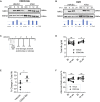Nrf2 Activation With CDDO-Methyl Promotes Beneficial and Deleterious Clinical Effects in Transgenic Mice With Sickle Cell Anemia
- PMID: 35620281
- PMCID: PMC9127300
- DOI: 10.3389/fphar.2022.880834
Nrf2 Activation With CDDO-Methyl Promotes Beneficial and Deleterious Clinical Effects in Transgenic Mice With Sickle Cell Anemia
Abstract
Activation of Nrf2, a major transcription factor that drives the antioxidant defense system, is an emerging therapeutic strategy in Sickle Cell Disease (SCD). In this study, transgenic Sickle Cell Anemia mice (SS mice) treated with CDDO-Methyl (CDDO-Me), a potent Nrf2 activator, showed reduced progression of hemolytic anemia with aging, but surprisingly also showed reduced endothelial function. Pulmonary vessels isolated from SS mice treated for 4 months with CDDO-Me displayed a diminished response to nitric oxide (NO)-induced vasodilation compared to littermates given vehicle. It is unclear what molecular mechanism underly the vascular impairment, however, our in vitro assays revealed that CDDO-Me induced the expression of the endothelin receptor (ETA and ETB) in vascular smooth muscle cells. Endothelin signaling is associated with increased vascular tone and vasoconstriction. This study underscores the importance of pre-clinical benefit-risk investigations of Nrf2 activating compounds which may be used to treat patients with SCD.
Keywords: CDDO-methyl (CDDO-Me); dimethyl fumarate (DMF); endothelin receptor (ET); nuclear factor erythroid 2-like 2 (Nrf2); sickle cell anemia.
Copyright © 2022 Ihunnah, Ghosh, Hahn, Straub and Ofori-Acquah.
Conflict of interest statement
The authors declare that the research was conducted in the absence of any commercial or financial relationships that could be construed as a potential conflict of interest.
Figures


Similar articles
-
Dimethyl fumarate and the oleanane triterpenoids, CDDO-imidazolide and CDDO-methyl ester, both activate the Nrf2 pathway but have opposite effects in the A/J model of lung carcinogenesis.Carcinogenesis. 2015 Jul;36(7):769-81. doi: 10.1093/carcin/bgv061. Epub 2015 May 4. Carcinogenesis. 2015. PMID: 25939751 Free PMC article.
-
Control of Oxidative Stress and Inflammation in Sickle Cell Disease with the Nrf2 Activator Dimethyl Fumarate.Antioxid Redox Signal. 2017 May 10;26(14):748-762. doi: 10.1089/ars.2015.6571. Epub 2016 Mar 30. Antioxid Redox Signal. 2017. PMID: 26914345 Free PMC article.
-
The Triterpenoid Nrf2 Activator, CDDO-Me, Decreases Neutrophil Senescence in a Murine Model of Joint Damage.Int J Mol Sci. 2023 May 15;24(10):8775. doi: 10.3390/ijms24108775. Int J Mol Sci. 2023. PMID: 37240121 Free PMC article.
-
Endothelin and endothelin antagonists: pharmacology and clinical implications.Agents Actions Suppl. 1995;45:237-53. doi: 10.1007/978-3-0348-7346-8_34. Agents Actions Suppl. 1995. PMID: 7717186 Review.
-
CDDO and Its Role in Chronic Diseases.Adv Exp Med Biol. 2016;929:291-314. doi: 10.1007/978-3-319-41342-6_13. Adv Exp Med Biol. 2016. PMID: 27771930 Review.
Cited by
-
Innovations in Drug Discovery for Sickle Cell Disease Targeting Oxidative Stress and NRF2 Activation-A Short Review.Int J Mol Sci. 2025 Apr 28;26(9):4192. doi: 10.3390/ijms26094192. Int J Mol Sci. 2025. PMID: 40362428 Free PMC article. Review.
-
Nrf2-dependent effects of CDDO-Me on bactericidal activity in macrophage infection models.Front Immunol. 2025 May 1;16:1574776. doi: 10.3389/fimmu.2025.1574776. eCollection 2025. Front Immunol. 2025. PMID: 40376003 Free PMC article.
-
Development of Potential Therapeutic Agents from Black Elderberries (the Fruits of Sambucus nigra L.).Molecules. 2024 Jun 22;29(13):2971. doi: 10.3390/molecules29132971. Molecules. 2024. PMID: 38998923 Free PMC article. Review.
References
-
- Chin M. P., Reisman S. A., Bakris G. L., O'Grady M., Linde P. G., McCullough P. A., et al. (2014). Mechanisms Contributing to Adverse Cardiovascular Events in Patients with Type 2 Diabetes Mellitus and Stage 4 Chronic Kidney Disease Treated with Bardoxolone Methyl. Am. J. Nephrol. 39 (6), 499–508. 10.1159/000362906 - DOI - PubMed
LinkOut - more resources
Full Text Sources
Molecular Biology Databases

